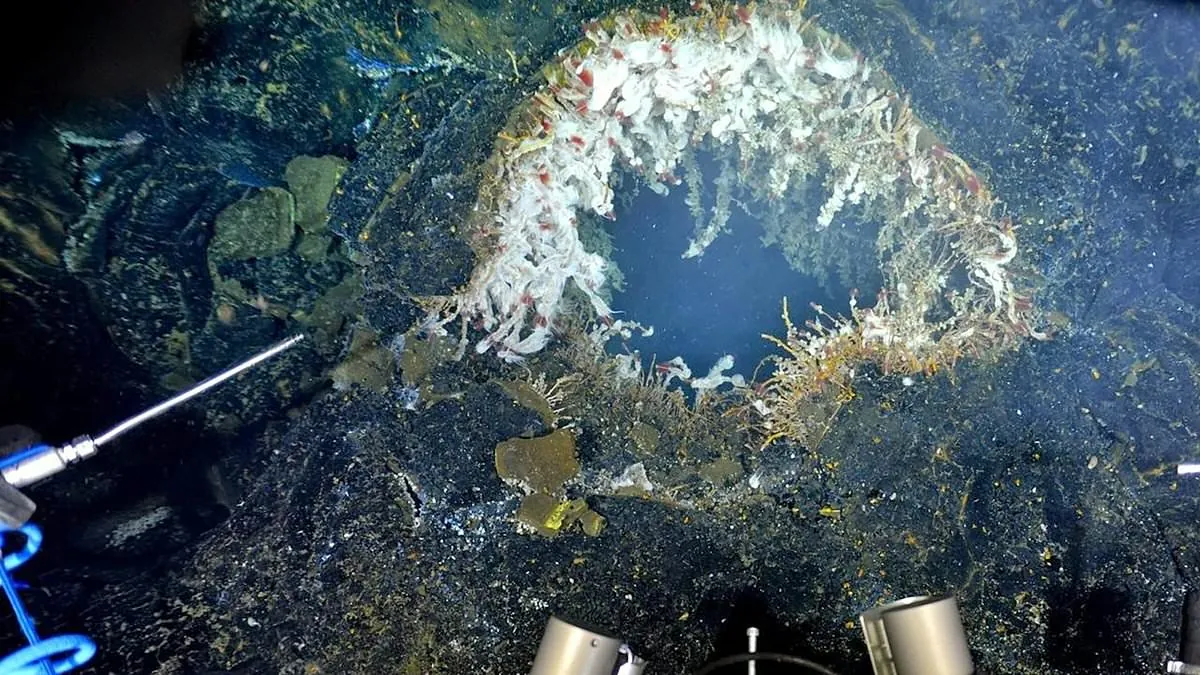An underwater volcano off the West Coast is predicted to erupt at any moment, and the world can watch it happen live.
Axial Seamount, located roughly 300 miles off Oregon’s coast on the Juan de Fuca Ridge, is the most active volcano in the Pacific Northwest.
The livestream runs daily at 2:00, 5:00, 8:00, and 11:00 ET and PT in 14-minute segments on the Interactive Oceans website.
However, the rate of swelling has recently sped up again, and the total rise is close to what it was before the 2015 eruption.
Despite its power, experts say Axial Seamount poses no threat to human communities.
Any moment now, an underwater volcano off the West Coast is expected to erupt, and the world can watch it live.
Located on the Juan de Fuca Ridge approximately 300 miles off the coast of Oregon, Axial Seamount is the most active volcano in the Pacific Northwest.
Recently, researchers keeping an eye on the underwater monster installed a camera close to its peak so that anyone can watch as it detonates.
Every day at 2:00, 5:00, 8:00, and 11:00 ET and PT, the Interactive Oceans website will broadcast a 14-minute livestream.
According to a statement from the Ocean Observations Initiative, “the HD video focuses on the 14-foot tall actively venting hot spring deposit called ‘Mushroom’ located within the ASHES vent field on Axial Seamount, located on the western side of the volcano.”.
White bacterial mats and tiny tube worms line the radiating fissures of the vent, which is situated atop an old lava flow. These are obvious indications that warm fluids are slowly leaking through the basalt’s cracks.
The seafloor abruptly collapsed by almost eight feet during its most recent eruption in 2015, which also caused lava flows hundreds of feet thick and about 8,000 earthquakes.
Bill Chadwick, a volcano expert, told KGW that it is at or nearly at the inflation threshold where it erupted the last time. Thus, we believe it to be ready. “…
More than 4,900 feet below the surface of the Pacific Ocean, the volcano is displaying strong indications of an imminent eruption as the seafloor’s pressure continues to rise.
The seafloor within a 25-mile radius underwent a dramatic change when the volcano’s subterranean magma chamber suddenly emptied.
The Axial Seamount behaves similarly to the volcanoes in Hawaii and is expected to erupt at any time more than a billion cubic feet of “very fluid lava” weighing millions of tons, according to Chadwick, a volcanologist and research professor at Oregon State University.
In between eruptions, they often swell up like a balloon. Chadwick stated, “The seafloor is actually rising at Axial, and that’s a big signal.”.
This year’s magma explosion could result in a lava flow almost as tall as Seattle’s Space Needle, he added, citing the 2015 eruption as evidence.
This magma pushing to the surface is what has caused a huge increase in earthquakes beneath the seamount in recent weeks.
As magma flows out of the seafloor volcano during this event, the number of underwater earthquakes is predicted to increase dramatically, from the several hundred that occur each day currently to 10,000 earthquakes in a 24-hour period.
A recent study found that there has been no success in forecasting the next eruption of Axial Seamount since 2015 due to a steady slowdown in seafloor swelling between 2015 and 2023.
The overall rise is nearly identical to what it was prior to the 2015 eruption, but the rate of swelling has recently accelerated once more.
When Chadwick noticed that the seafloor was swelling to almost the same height as it had been prior to the most recent eruption, he started looking into Axial in November 2024.
According to a 2024 study, “The volcano has suddenly woken up.”.
The volcano’s shape and behavior change quickly during this awakening, especially due to a process called inflation, in which magma pushes upward and causes the seafloor above to swell.
Imagine it as if you were blowing up a balloon until it burst.
Thanks to the Ocean Observations Initiative, which set up a network of GPS, pressure sensors, and a high-definition camera system close to the seamount, the 2015 eruption was a watershed moment for underwater volcano monitoring.
The history of eruptions at Axial is well documented, with records dating back to 1998, 2011, and 2015.
More accurate forecasts were made possible by the 2015 eruption, which was the first to be captured nearly in real-time, whereas the previous two eruptions were only discovered after the fact.
Experts claim that despite its strength, Axial Seamount is not a threat to human populations.
Because it is too deep and far offshore, people cannot detect its eruptions, and it has no effect on land-based seismic activity.
According to Chadwick, it is most likely the world’s best-monitored underwater volcano.
Scientists have a unique opportunity to gain a better understanding of underwater volcanic eruptions, which are more difficult to observe and forecast than their terrestrial counterparts, by monitoring Axial.







